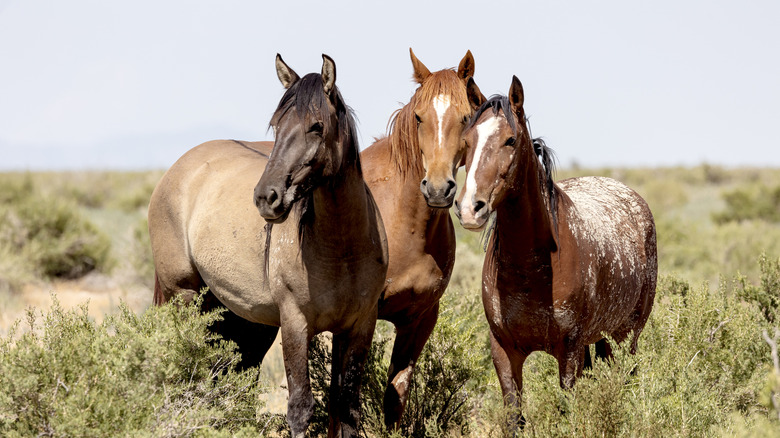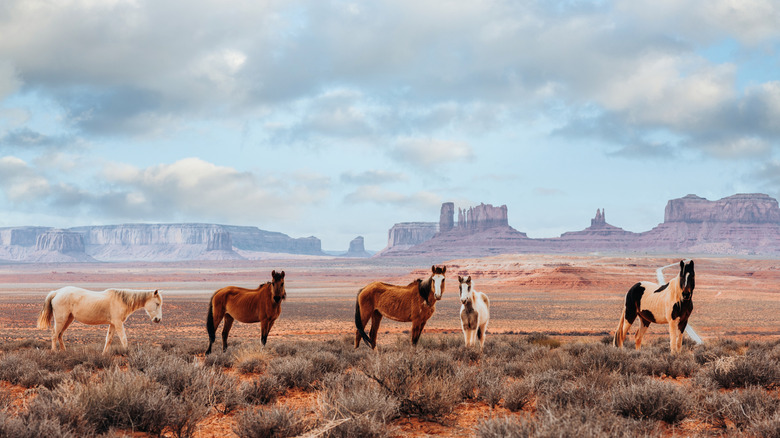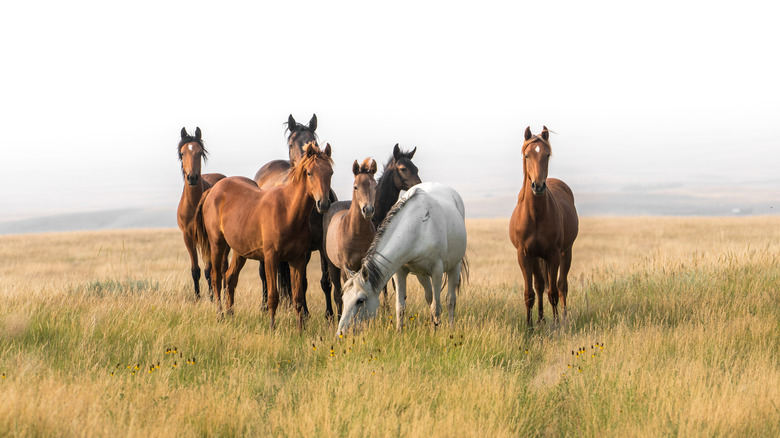Tragic Theories Why Horses Once Went Extinct In North America
The United States has the most horses in the world, with a population of more than 10.3 million animals. That's roughly 18% of all horses. The country is also home to more than a hundred registered breeds, which remains the most diverse array of Equidae — the taxonomic family to which horses belong — in the world. Second on the list of countries with the highest population of horses is Mexico, with 6.4 million, making North America the de facto horse capital of the world.
With that in mind, it's strange to think that horses were at one time completely absent from North America. The animals were once abundant on the continent, and remained so for millions of years. Around 10,000 years ago, however, almost all of North America's large mammals went extinct, and horses were not spared. It wasn't until the 1400s that the animals made their way back to the continent via Spanish conquistadors who introduced European horses to the land. That means that the horses seen in North America today are, technically, a non-native species.
Why were horses wiped out on the continent in the first place? Well, scientists are actually less certain about why horses disappeared from North America than they are about why dinosaurs were wiped out.
Horses persisted past a major extinction event
At one time, North America was home to some of horses' earliest ancestors, which lived roughly 30 to 40 million years ago. Over the following years, these small, three-toed creatures evolved into larger single-toed animals which closely resembled the horses we know today. These North American horses, known as Equus scotti, became widespread up until about 10,000 years ago (though this estimate has been contested), when they went extinct. The reason for the disappearance of the North American horse is widely debated, and a definitive explanation is yet to emerge. There are, of course, many theories.
We do know that the North American horse survived beyond the timeframe of a major mass-extinction event. The Quaternary period in which we live is made up of two epochs; the Pleistocene, which began 1.8 million years ago and ended 11,000 years ago, and the Holocene epoch in which we find ourselves today. In the late Pleistocene, large-scale megafaunal extinctions took place which, though smaller than the big five mass extinction events in history, affected animals such as the giant kangaroo, which eventually went extinct, and saw the complete extinction of large organisms weighing roughly 110 pounds or more. This includes creatures such as saber-toothed cats, mammoths, and mastodons.
But horses seem to have persisted. In 2021, a team of scientists looked at ancient DNA remnants in soil and published their findings in a paper in Nature Communications. They found that North American horse numbers were in decline before the transition from the Pleistocene to the Holocene. But they also discovered that horses (and woolly mammoths) were still present in North America as early as 6,000 years ago, meaning they survived well beyond the traditional timeframe of the megafaunal extinctions of the late Pleistocene. This complicates an already complex picture, as it shows that North American horses persisted long after what was thought to have been their extinction from the fossil record.
Climate change and human hunters contributed to the North American horse's extinction
Explaining the disappearance of the North American horse is complicated but scientists have developed several theories. As the world moved from the Pleistocene epoch, during which the last ice age occurred, the landscape and vegetation of our world changed. E. scotti was a grazing herbivore, and relied mostly on grassland for sustenance. These climate shifts would therefore have had a significant impact on the animal, changing their eating patterns and interfering with their habitats.
Another reason often adduced for the animal's decline is the arrival of human hunters. Evidence suggests that humans hunted horses on the continent, which would have exacerbated existing pressures on the species. Back in 2001, pony-sized horses were discovered by University of Calgary scientists in the dry bed of the St. Mary Reservoir in southern Alberta. Some of the horse's vertebrae had been smashed and what appeared to be butcher marks were found on its bones. This discovery provided compelling evidence that overhunting by humans was a factor in the extinction of E. scotti.
In a 2015 paper published in the Proceedings of the National Academy of Sciences, researchers studied the skeletal remains of seven horses and one camel who had been attacked and butchered by prehistoric hunters in an area south of Calgary, Canada. Based on radiocarbon dating, the team confirmed that the animals had been killed around 13,300 years ago, which was roughly 300 years earlier than hunters were thought to have been active, noting how other similar sites in North America prove that humans hunted several types of megafauna for at least 2,000 years before they went extinct. In other words, horses and other mammals were facing a threat from human hunters for some time before they were completely wiped out. Even with this evidence, however, there remains a debate over whether humans were directly responsible for the extinction of the North American horse, but it wouldn't be the first time humans changed the evolution of animals.
North American horses faced multiple threats to their existence
Although it's not clear whether human hunting or climate change can be directly blamed for the extinction of the North American horse, it's clear the species was under immense pressure from multiple angles. For instance, the spread of bison meant horses suddenly had to compete for food. Fossil records suggest that not only were horse ranges shrinking, the animals themselves were becoming smaller in size, hinting at a lack of food which was having a major impact on the physiology of the North American horse.
While new evidence is being discovered all the time, filling gaps in the fossil record, the demise of the North American horse almost certainly comes down to multiple factors. The species was already in decline due to a combination of climate change and changes to its vegetation and habitats. Human hunting no doubt exacerbated those issues, but it's by no means confirmed that humans are directly to blame for wiping out horses in North America. In fact, some scientists place the blame much more squarely on environmental factors, citing the massive changes that came with the ice age of the Pleistocene epoch, which would have turned grasslands into tundras, making it incredibly difficult for horses to graze.
Thankfully, horses made it out of North America across the Bering Land Bridge long before they became extinct on the continent. The animals spread to Eurasia around 1 million years ago, before diverging genetically from the North American horse. Its these creatures that were reintroduced to North America in the 1400s, and though these modern versions of the animals are not the same species as those that roamed North America until their extinction, they at least carry on the lineage of those incredible animals.



